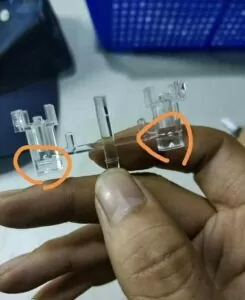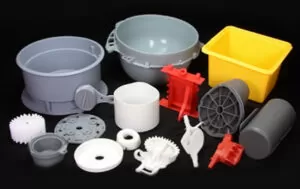Introduction
The control of the structural size of plastic material in the power supply casing is a very important part of the power supply design, because it is directly related to the use effect and appearance of the power supply. In the realm of electronics, injection molding plays a pivotal role in the production of power supply casings.

These casings house critical components of electronic devices, safeguarding them against environmental factors and mechanical stress. However, ensuring precise control over the structural dimensions of these casings is paramount to their functionality, reliability, and compatibility with other components.We will introduce the control of the structural size of the power supply housing from three aspects: design principles, size control and detection methods.
Importance of Structural Dimensions:
Precise structural dimensions are paramount for power supply casings due to several crucial reasons:
Ensuring Functionality:
Power supply casings serve as protective enclosures for sensitive electronic components. Precise structural dimensions are essential to ensure that all internal components fit securely within the casing. Any deviation from the intended dimensions may result in improper fitment, potentially leading to electrical short circuits, component damage, or even catastrophic failure of the power supply unit.

Maintaining Reliability:
Power supply casings are subjected to various environmental factors and mechanical stresses during operation. Precise structural dimensions help ensure the casing’s integrity and resistance to external forces. Deviations in dimensions can weaken the casing’s structural integrity, increasing the risk of deformation, cracks, or leaks. Such structural defects compromise the reliability of the power supply unit, leading to operational failures or safety hazards.
Facilitating Compatibility:
Power supply casings must be compatible with other components within the electronic device, such as circuit boards, connectors, and cooling systems. Precise structural dimensions ensure proper alignment and interface between different components, enabling seamless assembly and optimal performance of the device as a whole. Dimensional deviations can hinder compatibility, leading to assembly difficulties, functionality issues, or even incompatibility with standard components.
Consequences of dimensional deviations on product performance and reliability:
Performance Degradation:
Dimensional deviations in power supply casings can lead to suboptimal performance of the electronic device. Improper fitment or misalignment of internal components may disrupt airflow, impede heat dissipation, or cause electrical interference, resulting in reduced efficiency and performance of the power supply unit.
Increased Failure Rate:
Structural defects caused by dimensional deviations compromise the reliability and longevity of the power supply casing. Weak points, such as stress concentrations or inadequate sealing, may develop, making the plastic casing susceptible to premature failure due to mechanical or environmental stressors. This increases the likelihood of operational failures, downtime, and potential safety hazards for users.

Quality Assurance Concerns:
Dimensional deviations in power supply casings not only affect product performance but also reflect poorly on the manufacturer’s quality standards. Inconsistencies in dimensions may signal deficiencies in the manufacturing process, such as inadequate mold design, material selection, or process control. Such quality issues can erode customer trust in plastic products, damage brand reputation, and incur costly recalls or warranty claims.
In summary, precise control over the structural dimensions of power supply casings is crucial for ensuring functionality, reliability, and compatibility of electronic devices. Dimensional deviations can have detrimental effects on product performance and reliability, posing risks to user safety and manufacturer credibility. Therefore, manufacturers must prioritize dimensional accuracy in the production of injection molded power supply casings to deliver high-quality, reliable products to the market.
Key Factors Influencing Structural Dimensions:
Material Selection:
Impact of material choice on dimensional stability: The choice of material significantly influences the dimensional stability of injection molded parts, including power supply casings. Different plastic materials exhibit varying levels of both shrinkage rate and warpage during the cooling process, affecting the final dimensions of the molded parts. Materials with high shrinkage rates or poor dimensional stability may result in greater dimensional deviations in the finished product.
Optimal plastic materials for power supply casings: When selecting plastic materials for power supply casings, manufacturers prioritize characteristics such as dimensional stability, heat resistance, and mechanical strength. Commonly used materials include ABS (Acrylonitrile Butadiene Styrene), polycarbonate, and polypropylene. These materials offer favorable properties for power supply casings, including low shrinkage rates, good dimensional stability, high pressure,, and high impact resistance, ensuring reliable performance and longevity of the finished product.
Mold Design and Mold Cavity:
Role of mold cavity design in controlling dimensions: The design of the mold cavity plays a crucial role in determining the final dimensions of injection molded parts, including power supply casings. Features such as the shape and size of the cavity, gating system, and venting arrangement directly influence the flow of molten plastic and the distribution of material within the whole mold structure. Proper mold cavity design is essential for achieving uniform filling, minimizing shrinkage, and controlling dimensional accuracy in the finished parts.

Features like uniform wall thickness and ventilation grooves:
In designing the mold cavity for power supply casings, engineers aim to maintain uniform wall thickness throughout the part. Variations in wall thickness can lead to differential cooling rates and uneven shrinkage, resulting in dimensional variations and potential defects such as warpage or sink marks. Additionally, incorporating ventilation grooves in the mold cavity helps to expel air and gases during the injection molding process, ensuring complete filling at mold opening and preventing voids or trapped air pockets that could affect dimensions and surface finish.
Molding Process Parameters:
Influence of injection pressure, speed, and material temperature on dimensions: Various molding process parameters, including injection pressure, injection speed, and material temperature, exert significant influence on the dimensions of injection molded plastic parts made. Injection pressure determines the force applied to the molten plastic, affecting its flow behavior and packing density within the mold cavity.
Injection speed controls the rate at which the material is injected into the mold, impacting filling time and pressure distribution. Material temperature influences viscosity and fluidity, affecting flow characteristics and part quality. Optimal parameter settings are crucial for achieving consistent dimensional accuracy and minimizing variations in the finished parts.
Significance of parameters such as injection cycle, cooling time, and clamping force: In addition to injection parameters, other factors such as injection cycle, cooling time, and clamping force also play key roles in controlling dimensional accuracy in injection molding products. The injection cycle time, which includes filling, packing, and cooling phases, must be carefully optimized to balance production efficiency with part quality.
Cooling time directly affects the rate of solidification and shrinkage of the molded part, while clamping force ensures proper mold closure and dimensional stability during the molding process. Fine-tuning these parameters according to material properties, part geometry, and mold design specifications is essential for achieving optimal dimensional control and producing high-quality injection molded parts, including power supply casings.
Effective Strategies for Dimensional Control:
Design Optimization:
Design for manufacturability to ensure uniform wall thickness: One of the fundamental principles of injection molding design is to optimize the part geometry for manufacturability. This includes ensuring uniform wall thickness throughout the power supply casing, which helps minimize variations in cooling rates and reduces the risk of warpage or sink marks. By maintaining uniform wall thickness, designers can promote consistent material flow and distribution during the injection molding process, resulting in improved dimensional accuracy and structural integrity of the finished parts.
Considerations for minimizing forming defects:
In addition to uniform wall thickness, designers must consider various factors to minimize forming defects in injection molded power supply casings. This includes incorporating adequate draft angles, fillet radii, and ribbing features to facilitate part ejection and reduce the risk of internal stresses or shrinkage-induced defects. By optimizing part geometry and mold design, designers can mitigate common defects such as flash, short shots, and surface imperfections, ensuring higher quality and dimensional accuracy in the final products.
Process Control:
Measures for precise temperature control and monitoring: Precise control over temperature is critical for achieving dimensional accuracy in injection molding. This involves maintaining consistent material temperature, mold temperature, and auxiliary temperatures such as oil pressure and temperature in the hydraulic system. Advanced temperature control systems and monitoring devices enable operators to regulate and monitor temperature variations throughout the molding process, minimizing the risk of thermal gradients and dimensional deviations in the finished parts.
In-process monitoring and management techniques for dimensional accuracy:
Implementing in-process monitoring systems and management techniques is essential for ensuring dimensional accuracy during injection molding. Real-time monitoring of key process parameters, such as injection pressure, injection moulding speed, and cavity pressure, allows operators to identify and address deviations from target dimensions promptly. By continuously monitoring and adjusting process parameters, manufacturers can maintain tight tolerances and optimal flow value range dimensional control throughout the production cycle, resulting in consistent part quality and dimensional accuracy.

Quality Assurance Measures:
Remedial measures for addressing forming defects: Despite proactive design and process control measures, forming defects may still occur during injection molding. In such cases, it is crucial to implement remedial measures to address these defects and salvage defective parts. This may involve post-molding operations such as trimming, reaming, or surface finishing to remove excess material or improve surface quality. By implementing effective quality control procedures and corrective actions, manufacturers can minimize the impact of forming defects on dimensional accuracy and overall part quality.
Adjustments in injection speed and temperature for improved part quality:
In addition to addressing forming defects, operators can make adjustments to injection speed and temperature to improve part quality and dimensional accuracy. Fine-tuning injection parameters based on material properties, part geometry, and injection molding machine design specifications allows operators to optimize filling behavior, reduce cycle times, and enhance dimensional control. By continuously monitoring and adjusting injection parameters, manufacturers can achieve higher levels of part quality and dimensional accuracy, ultimately enhancing product performance and customer satisfaction.
Power supply housing mold design principles
The design principle of the power supply housing structure is to meet the following requirements:
Comply with the principles of mechanical structure, which must not only ensure the stability and reliability of the power supply, but also meet the requirements of beautiful appearance.
Comply with the principle of electrical structure, which not only ensures the electrical performance and safety performance of the power supply, but also meets the requirements of beautiful appearance.
In line with the principles of ergonomics, it is necessary to ensure the optimal flow, comfort and convenience of using the power supply, and at the same time meet the requirements of beautiful appearance.
Power supply shell size control
The control of the structural dimensions of the power supply casing refers to the strict control and management of the structural dimensions raw materials of the power supply casing during the design and manufacturing process to ensure the quality and performance of the power supply. The specific control methods are as follows:
1. Determine the size range:
Before designing cooling system, it is necessary to determine the size range of the power supply housing structure, including length, width, height, etc., as well as the spacing and gaps between various components.
2. Establish dimensional standards:
After determining the size range, it is necessary to formulate dimensional standards for the power supply housing structure, including standards for dimensional tolerances, dimensional deviations, dimensional errors, wall thickness ratio etc.
3. Develop testing methods:
After formulating the size standards, it is necessary to formulate testing methods for the structural dimensions of the power supply casing, including testing tools, testing methods, testing standards, temperature requirements etc.

4. Strengthen quality control:
During the manufacturing process, it is necessary to strengthen quality control on the structural dimensions of the power supply casing, including measures to strengthen process control, strengthen inspection control, and strengthen quality management.
Power supply casing detection method
The detection method of the structural dimensions of the power supply casing refers to detecting and testing the structural dimensions of the power supply casing during the manufacturing process to ensure the quality and performance of the power supply. The specific detection methods are as follows:
Use inspection tools:
During the inspection process, it is necessary to use various inspection tools, including calipers, vernier calipers, height gauges, parallel rulers and other tools to ensure the accuracy of dimensions.
Establish testing standards
During the testing process, it is necessary to formulate testing standards for the structural dimensions of the power supply casing, including standards for dimensional tolerance, dimensional deviation, dimensional error, etc.
Strengthen detection control
During the detection process, it is necessary to strengthen the detection and control of the structural dimensions physical properties of the power supply casing, including strengthening the calibration of detection tools and strengthening the training of detection personnel.

Conclusion:
In conclusion, achieving precise structural dimensions in injection molded power supply casings is paramount for ensuring product functionality, reliability, and compatibility. Throughout this article, we have emphasized the critical importance of dimensional control and explored key strategies for achieving it effectively.
However, achieving dimensional control requires a holistic approach that integrates various factors, including material selection, mold design, molding process optimization, and quality assurance measures. Designing for manufacturability, optimizing process parameters, and implementing in-process monitoring are essential steps in this process. By addressing each aspect comprehensively, manufacturers can ensure consistent dimensional accuracy and produce high-quality power supply casings that meet stringent standards.
Furthermore, as the manufacturing landscape continues to evolve, it is crucial for manufacturers to embrace continuous improvement and innovation. By staying abreast of advancements in materials, technologies, and methodologies, manufacturers can adapt to changing market demands and maintain a competitive edge. Continuous improvement ensures that manufacturing processes remain efficient, reliable, and capable of delivering products with precise structural dimensions and superior quality.
In conclusion, achieving precise structural dimensions in injection molded power supply casings requires a multifaceted approach, encompassing material selection, mold design, process optimization, and quality assurance. By adopting a holistic approach and embracing continuous improvement, manufacturers can uphold high standards of dimensional accuracy, ensuring the reliability and satisfaction of their customers in an ever-evolving manufacturing landscape.






